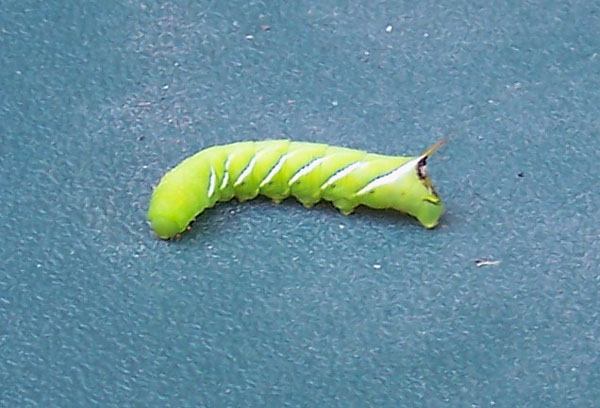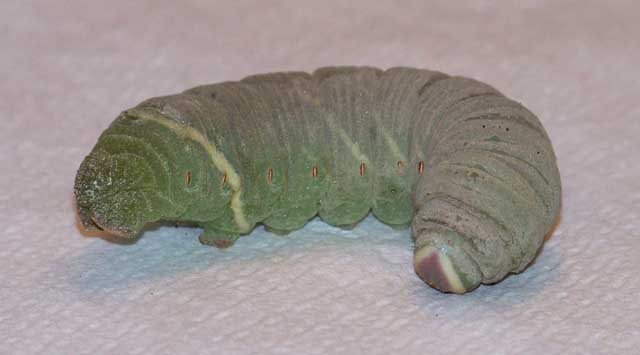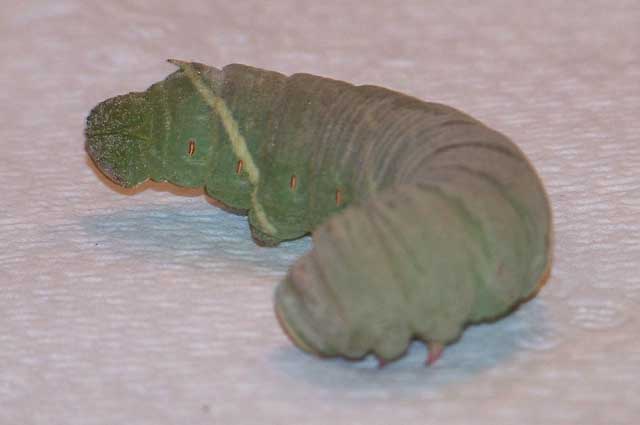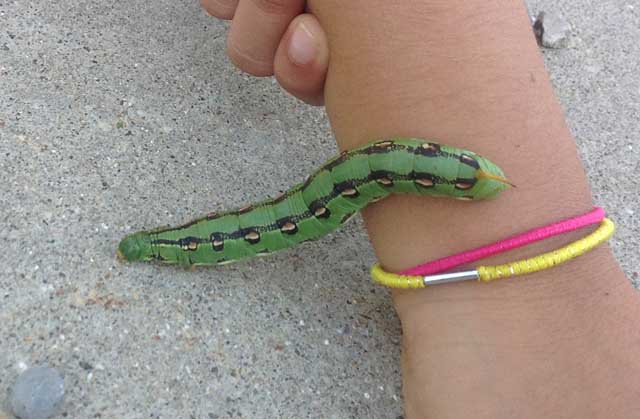Lake County, Illinois
Sphingidae Larvae

|
|
Created/dedicated as per personal communication with Julie Paradowski, (Manduca sexta), September 15, 2007 Updated as per personal communication with Tim and Emma Soderstrom, (Pachysphinx modesta), August, 2008 Updated as per James P. Tuttle's The Hawk Moths of North America, August 26, 2008 Updated as per personal communication with Katherine Crespo and father Guillermo Crespo, (Hyles lineata), September 26, 2013 Updated as per BAMONA, September 26, 2013 |

This page is inspired by and dedicated to Juliet Paradowski who found the Manduca sexta larva on September 15, 2007, in Waukegan.
Juliet writes, "I found this caterpillar on one of my tomato plants today while I was clearing-out my garden. I think it is a
Sphinginae, but I couldn't ID it for sure. It was found in Waukegan, in Lake County, IL. Can you positively ID it from the pictures?"
Thanks also to Tim and Emma Soderstrom who sent me the Pachysphinx modesta
images below, August 26, 2008.
Tim writes, "Good afternoon! I was wondering if you could help me and my 7 year old daughter figure out what kind of caterpillar this is.
I have attached two photos of the caterpillar for you to look at. I found it on a walk in northern Illinois, on August 26th.
It was crawling across a stone path in a wooded area. It is about 3" to 4" long and is a pale green color. What can wee feed it?
Could it be a type of hawk moth?"
I replied, "It is Pachysphinx modesta, the Poplar sphinx, also called the Modest Sphinx.
"It is done feeding and is ready to pupate. Put it in a little plastic tub with a paper towel on the bottom. Lid on tight, no airholes. In four or five days it will shed its skin and form a pupa.
"It will shrink considerably and give off quite a bit of moisture during the four to five days before it sheds its skin to the pupal stage.
"Please let me know which Illinois county as I am in process of creating county by county pictoral checklists and would like to use your image with credit to you??"

Pachysphinx modesta, Lake Bluff, Lake County, Illinois,
August 26, 2008, Tim and Emma Soderstrom.

Pachysphinx modesta, Lake Bluff, Lake County, Illinois,
August 26, 2008, Tim and Emma Soderstrom.
It is hoped that this checklist, with the thumbnails and notes, will help you quickly identify the larvae you have encountered.
A WO" after the species name indicates that I have no confirmed reports of this species in Chippewa County, but I (William Oehlke) expect that this species is present.
Please help me develop this list with improved, documented accuracy by sending sightings (species, date, location), preferably with an image, via email to Bill Oehlke.
Please also send your sightings to BAMONA, an excellent online resource which has replaced USGS, incorporating and expanding the data base.
Many thanks to Katherine and Guillermo Crespo who provide the Hyles lineata image below.

Hyles lineata, Highland Park, Lake County, Illinois,
September 25, 2013, courtesy of Katherine Crespo and Guillermo Crespo.
I reply, "Here is my Lake County Sphingidae larvae checklist: http://www.silkmoths.bizland.com/ilLakesphlar.htm. Hyles lineata is reported throughout the state of Illinois. I wish permission to add your image of lineata larva, credited to you, to Lake County page??"
Visit Lake County Sphingidae: Adult Moths
Visit Illinois catocala: Underwing Moths
Sphinginae subfamily
Smerinthini Tribe:
Macroglossinae subfamilyDilophonotini Tribe:
See Hemaris comparison to help distinguish the next three species.
Philampelini Tribe:
Macroglossini Tribe:
|
Eggs of many North American species are offered during the spring and summer. Occasionally summer Actias luna and summer Antheraea polyphemus cocoons are available. Shipping to US destinations is done from with in the US.
Use your browser "Back" button to return to the previous page.
This page is brought to you by Bill Oehlke and the WLSS. Pages are on space rented from Bizland. If you would like to become a "Patron of the Sphingidae Site", contact Bill.
Please send sightings/images to Bill. I will do my best to respond to requests for identification help.
 Show appreciation for this site by clicking on flashing butterfly to the left. The link will take you to a page with links to many insect sites. |
I very much appreciate all the many images that have been sent to me, or of which I have been granted permission to copy and post from other websites. All images on this site remain the property of respective photographers.
If you would like to contribute to the maintenace of this website by sending a contribution to
Bill Oehlke
Box 476
155 Peardon Road
Montague, Prince Edward Island, C0A1R0
Canada
your donation would be much appreciated and would be used for
1) paying for webspace rental;
2) paying for computer maintenance and software upgrades;
3) purchases of additional text reference material (journals and books) in anticipation of expanding the site to a worldwide Sphingidae site;
4) helping to pay my daughter's tuition (completed spring of 2013); with anything left over going to humanitarian aid.
If you are mailing a check from USA, please use $1.10 (2013 rate) postage. Donations can also be made through Paypal via the button below.